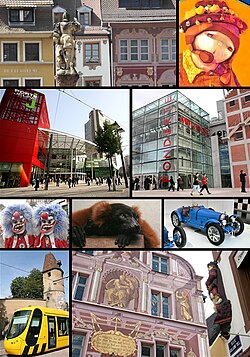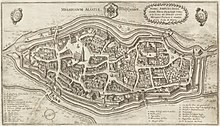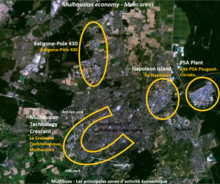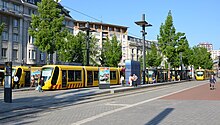Mulhouse
Mulhouse
Mìlhüsa (Alemannic German) | |
|---|---|
Subprefecture and commune | |
 | |
| Coordinates: 47°45′N 7°20′E / 47.75°N 7.34°E | |
| Country | France |
| Region | Grand Est |
| Department | Haut-Rhin |
| Arrondissement | Mulhouse |
| Canton | Mulhouse-1, 2 and 3 |
| Intercommunality | Mulhouse Alsace Agglomération |
| Government | |
| • Mayor (2020–2026) | Michèle Lutz[1] (LR) |
Area 1 | 22.18 km2 (8.56 sq mi) |
| • Urban | 239.1 km2 (92.3 sq mi) |
| Population (2022)[2] | 104,924 |
| • Density | 4,700/km2 (12,000/sq mi) |
| • Urban | 246,692 Metro 6,394,037 Oberrhein |
| Time zone | UTC+01:00 (CET) |
| • Summer (DST) | UTC+02:00 (CEST) |
| INSEE/Postal code | 68224 /68100, 68200 |
| Dialling codes | 0389, 0369 |
| Elevation | 232–338 m (761–1,109 ft) (avg. 240 m or 790 ft) |
| Website | www |
| 1 French Land Register data, which excludes lakes, ponds, glaciers > 1 km2 (0.386 sq mi or 247 acres) and river estuaries. | |
Mulhouse (pronounced [myluz] ⓘ; Alsatian: Mìlhüsa [mɪlˈhyːsa]; German: Mülhausen [myːlˈhaʊzn̩] ⓘ, meaning "mill house") is a French city of the European Collectivity of Alsace (Haut-Rhin department, in the Grand Est region of France). It is near the France–Switzerland border and France–Germany border. It is the largest city in Haut-Rhin and second largest in Alsace after Strasbourg.
Mulhouse is known for its museums, especially the Cité de l'Automobile (also known as the Musée national de l'automobile, 'National Museum of the Automobile') and the Cité du Train (also known as Musée Français du Chemin de Fer, 'French Museum of the Railway'), respectively the largest automobile and railway museums in the world.[citation needed] An industrial town nicknamed "the French Manchester",[4] Mulhouse is also the main seat of the Upper Alsace University, where the secretariat of the European Physical Society is found.
Administration
Mulhouse is a commune with a population of 108,312 in 2019.[5] This commune is part of an urban unit also named Mulhouse with 247,065 inhabitants in 2018.[3]
Additionally Mulhouse commune is the principal commune of the 39 communes which make up the communauté d'agglomération of Mulhouse Alsace Agglomération (m2A, population 280,000 in 2020).[6]
Mulhouse commune is a subprefecture, the administrative centre of the Arrondissement of Mulhouse. It is one of the most populated sub-prefectures in France.
History



In 58 BC a battle took place west of Mulhouse and opposed the Roman army of Julius Caesar by a coalition of Germanic people led by Ariovistus. The first written records of the town date from the twelfth century. It was part of the southern Alsatian county of Sundgau in the Holy Roman Empire. From 1354 to 1515, Mulhouse was part of the Zehnstädtebund, an association of ten Free Imperial Cities in Alsace. The city joined the Swiss Confederation as an associate in 1515 and was therefore not annexed by France in the Peace of Westphalia in 1648 like the rest of the Sundgau. An enclave in Alsace, it was a free and independent Calvinist republic, known as Stadtrepublik Mülhausen, associated with the Swiss Confederation until, after a vote by its citizens on 4 January 1798, it became a part of France in the Treaty of Mulhouse signed on 28 January 1798, during the Directory period of the French Revolution.
Starting in the middle of the eighteenth century, the Koechlin family pioneered cotton cloth manufacturing; Mulhouse became one of France's leading textile centers in the nineteenth century. André Koechlin (1789–1875) built machinery and started making railroad equipment in 1842. The firm in 1839 already employed 1,800 people. It was one of the six large French locomotive constructors until the merger with Elsässische Maschinenbau-Gesellschaft Grafenstaden in 1872, when the company became Société Alsacienne de Constructions Mécaniques.[7]
After the Prussian victory in the Franco-Prussian War (1870–1871), Mulhouse was annexed to the German Empire as part of the territory of Alsace-Lorraine (1871–1918). The city was briefly occupied by French troops on 8 August 1914 at the start of World War I, but they were forced to withdraw two days later in the Battle of Mulhouse. French forces then reoccupied the city again on 19 August, before retreating again on 28 August having suffered heavy casualties. Alsatians who celebrated the appearance of the French army were left to face German reprisals, with several citizens sentenced to death. After World War I ended in 1918, French troops entered Alsace, and Germany ceded the region to France under the Treaty of Versailles. After the Battle of France in 1940, it was occupied by German forces until its return to French control at the end of World War II in May 1945.
The town's development was stimulated first by the expansion of the textile industry and tanning, and subsequently by chemical and Engineering industries from the mid 18th century. Mulhouse was for a long time called the French Manchester. Consequently, the town has enduring links with Louisiana, from which it imported cotton, and also with the Levant. The town's history also explains why its centre is relatively small.
Geography
Two rivers run through Mulhouse, the Doller and the Ill, both tributaries of the Rhine. Mulhouse is approximately 100 kilometres (62 miles) from Strasbourg and Zürich; it is 350 km (217 mi) from Milan and about 340 km (211 mi) from Frankfurt. It is close to Basel, Switzerland and Freiburg, Germany. It shares the EuroAirport international airport with these two cities.[8]
Districts
Medieval Mulhouse consists essentially of a lower and an upper town.
- The lower town was formerly the inner city district of merchants and craftsmen. It developed around the Place de la Réunion (which commemorates its reunion with France). Nowadays this area is pedestrianised.
- The upper town developed from the eighteenth century on. Previously, several monastic orders were established there, notably the Franciscans, Augustinians, Poor Clares and Knights of Malta.
- The Nouveau Quartier (New District) is the best example of urban planning in Mulhouse, and was developed from 1826 on, after the town walls had been torn down (as they were in many towns in France). It is focused around the Place de la République. Its network of streets and its triangular shape are a good demonstration of the town's desire for a planned layout. The planning was undertaken by the architects G. Stolz and Félix Fries. This inner city district was occupied by rich families and the owners of local industries, who tended to be liberal and republican in their opinions.
- The Rebberg district consists of grand houses inspired by the colonnaded residences of Louisiana cotton planters. Originally, this was the town's vineyard (the word Rebe meaning vine in German). The houses here were built as terraces in the English style, a result of the town's close relationship with Manchester, where the sons of industrialists were often sent to study.
Climate
Mulhouse's climate is temperate oceanic (Köppen: Cfb), but its location further away from the ocean gives the city colder winters with some snow, and often hot and humid summers, in comparison with the rest of France.
| Climate data for Mulhouse (1991–2020 normals, sun from Mulhouse Airport, extremes 1947−present) | |||||||||||||
|---|---|---|---|---|---|---|---|---|---|---|---|---|---|
| Month | Jan | Feb | Mar | Apr | May | Jun | Jul | Aug | Sep | Oct | Nov | Dec | Year |
| Record high °C (°F) | 18.8 (65.8) |
21.7 (71.1) |
26.5 (79.7) |
30.0 (86.0) |
33.3 (91.9) |
37.0 (98.6) |
38.9 (102.0) |
39.4 (102.9) |
33.7 (92.7) |
29.6 (85.3) |
24.3 (75.7) |
19.9 (67.8) |
39.1 (102.4) |
| Mean daily maximum °C (°F) | 5.3 (41.5) |
7.4 (45.3) |
12.0 (53.6) |
16.5 (61.7) |
20.5 (68.9) |
24.3 (75.7) |
26.4 (79.5) |
26.3 (79.3) |
21.5 (70.7) |
15.9 (60.6) |
9.6 (49.3) |
6.0 (42.8) |
16.0 (60.7) |
| Daily mean °C (°F) | 2.3 (36.1) |
3.4 (38.1) |
7.0 (44.6) |
10.6 (51.1) |
14.7 (58.5) |
18.4 (65.1) |
20.3 (68.5) |
20.0 (68.0) |
15.9 (60.6) |
11.3 (52.3) |
6.2 (43.2) |
3.2 (37.8) |
11.1 (52.0) |
| Mean daily minimum °C (°F) | −0.6 (30.9) |
−0.5 (31.1) |
1.9 (35.4) |
4.7 (40.5) |
8.9 (48.0) |
12.4 (54.3) |
14.1 (57.4) |
13.8 (56.8) |
10.2 (50.4) |
6.7 (44.1) |
2.7 (36.9) |
0.3 (32.5) |
6.2 (43.2) |
| Record low °C (°F) | −20.2 (−4.4) |
−21.5 (−6.7) |
−17.2 (1.0) |
−6.3 (20.7) |
−3.1 (26.4) |
0.9 (33.6) |
4.3 (39.7) |
4.0 (39.2) |
−0.6 (30.9) |
−6.7 (19.9) |
−13.4 (7.9) |
−19.0 (−2.2) |
−21.5 (−6.7) |
| Average precipitation mm (inches) | 57.9 (2.28) |
49.2 (1.94) |
49.9 (1.96) |
49.9 (1.96) |
78.2 (3.08) |
67.8 (2.67) |
63.0 (2.48) |
67.1 (2.64) |
61.1 (2.41) |
69.7 (2.74) |
58.7 (2.31) |
75.1 (2.96) |
747.6 (29.43) |
| Average precipitation days | 9.3 | 9.1 | 8.4 | 8.5 | 11.4 | 9.8 | 9.5 | 9.4 | 8.4 | 10.2 | 9.5 | 10.7 | 114.2 |
| Average relative humidity (%) | 84 | 81 | 75 | 72 | 74 | 74 | 72 | 76 | 80 | 84 | 85 | 84 | 78.4 |
| Mean monthly sunshine hours | 68 | 91 | 146 | 181 | 202 | 228 | 248 | 234 | 168 | 121 | 70 | 62 | 1,819 |
| Source 1: Météo France[9] | |||||||||||||
| Source 2: Infoclimat.fr (humidity 1961–1990)[10] | |||||||||||||
| Town | Sunshine (hours/yr) |
Rain (mm/yr) |
Snow (days/yr) |
Storm (days/yr) |
Fog (days/yr) |
|---|---|---|---|---|---|
| National average | 1,973 | 770 | 14 | 22 | 40 |
| Mulhouse | 1,783.8 | 772.1 | 32.5 | 33.2 | 54.9[12] |
| Paris | 1,661 | 637 | 12 | 18 | 10 |
| Nice | 2,724 | 767 | 1 | 29 | 1 |
| Strasbourg | 1,693 | 665 | 29 | 29 | 56 |
| Brest | 1,605 | 1,211 | 7 | 12 | 75 |
Population
The population data in the table and graph below refer to the commune of Mulhouse proper, in its geography at the given years. The commune of Mulhouse absorbed the former commune of Dornach in 1914 and Bourtzwiller in 1947.[13]
|
| ||||||||||||||||||||||||||||||||||||||||||||||||||||||||||||||||||||||||||||||||||||||||||||||||||||||||||||||||||
| |||||||||||||||||||||||||||||||||||||||||||||||||||||||||||||||||||||||||||||||||||||||||||||||||||||||||||||||||||
| Source: EHESS[13] and INSEE (1968–2017)[14] | |||||||||||||||||||||||||||||||||||||||||||||||||||||||||||||||||||||||||||||||||||||||||||||||||||||||||||||||||||
Main sights




- Hôtel de Ville (1552). The town hall was built in 1553 in the Rhenish Renaissance style. Montaigne described it as a "palais magnifique et tout doré" ("splendid golden palace") in 1580. It is known for its trompe-l'œil paintings, and its pictures of allegories representing the vices and virtues.
- Workers' quarter (mid 19th century), inspired workers' quarters in many other industrial towns.[15]
- Place de la Bourse and the building of the Société Industrielle de Mulhouse, in the Nouveau Quartier (19th century)
- Cité de l'Automobile (featuring the Schlumpf collection)
- Cité du Train successor to Musée Français du Chemin de Fer (French National Railway Museum)
- Museum of Electricity (Electropolis)
- Musée des Beaux-Arts (Fine Arts Museum)
- Musée historique (History Museum, located in the Hôtel de Ville)
- Museum of Printed Textiles (Musée de l'impression sur étoffes)
- The Parc Zoologique et Botanique de Mulhouse (botanical garden and zoo)
- Saint-Steffen Calvinist temple (1859–1869), by Jean-Baptiste Schacre
- Miscellaneous Street art works all around the town, amongst them a picture of Milhouse van Houten from The Simpsons as his name is pronounced similarly to Mulhouse in the French-dubbed version.
Principal economic activities


As early as the mid-19th century, Mulhouse was known as "the industrial capital of Alsace", the "city with a hundred chimneys" (cité aux cent cheminées) and "the French Manchester".[15]
- Automobile industry (Peugeot's Mulhouse factory is the largest employer in Alsace)
- Chemical industry (ICMD)
- Electronics (Clemessy)
- Engineering (SACM – Wärtsilä)
Between 1909 and 1914 there was an aircraft manufacturer, Aviatik, in Mulhouse.[16]
Education
The École nationale supérieure de chimie de Mulhouse, the first school of Chemistry in France, is located in the city.[17]
Transport

Air
Mulhouse is served by EuroAirport Basel-Mulhouse-Freiburg, located 25 km (16 mi) south of the town.
Rail
Gare de Mulhouse is well connected with the rest of France by train, including major destinations such as Paris, Dijon, Besançon, Belfort, Strasbourg, Lyon, Marseille, Montpellier and Lille. Some trains operate to destinations in Switzerland, in particular proximity Basel, Bern and Zürich. There is also a train service to Frankfurt am Main in Germany, and a Eurocity service that connects Brussels, Luxembourg, Strasbourg and Basel calls at Mulhouse.
Regional services connect Mulhouse to Colmar, Strasbourg, Basel, Belfort, Kruth and Freiburg im Breisgau.
Urban transport
Transport within Mulhouse is provided by Soléa and comprises a network of buses together with the city's tram network, which opened on 13 May 2006. The tramway now consists of three tram lines and one tram-train line.
- Line 2 from Nouveau Bassin to Coteaux
- Line 1 from Gare Centrale to Châtaignier
- Line 3 from Gare Centrale to Lutterbach
- Tram-train line from Gare Centrale to Thann via Lutterbach
Road
Motorway A36 is the main axis connecting the city with the west of the country, to cities such as Dijon, Paris and Lyon. The A35 is the main north–south axis, connecting cities such as Strasbourg and Basel.
Sports
Mulhouse is one of the nation's hubs for women's volleyball. ASPTT Mulhouse won multiple titles at the National level. The team plays its home games at the Palais des Sports.
Additionally, FC Mulhouse Basket is based in Mulhouse.
People
Mulhouse was the birthplace of:
- Maurice Achener (1881–1963), French illustrator, painter, and print maker
- Jean de Beaugrand (1584–1640), lineographer and mathematician
- Serge Blenner (born 1955), composer and synthesist
- Bernard Bloch (born 1949), actor and director
- Jean Brenner (1937–2009), painter
- Karl Brandt (1904–1948), German Nazi personal physician to Adolf Hitler and head administrator of the T-4 Euthanasia Program, executed for war crimes
- David Cage (born 1969), French video game designer, writer and musician. Born in Mulhouse, Cage was the first game developer to receive the Legion of Honour,[18] the highest decoration granted in France.[19]
- Pierre Chambon (born 1931), biologist
- Cléopatre Darleux (born 1989), handball goalkeeper
- Mireille Delunsch (born 1962), soprano
- Tom Dillmann (born 1989), racing driver
- Artur Dinter (1876–1948), writer and Nazi politician
- Dorian Diring (born 1992), footballer
- Adrien Dollfus (1858–1921), French zoologist and carcinologist
- Jean Dollfus (1800–1887), French industrialist
- Jean Dorst (1924–2001), ornithologist
- Alfred Dreyfus (1859–1935), French military officer best known for being the focus of the Dreyfus affair
- Huguette Dreyfus (1928–2016), harpsichordist
- Léon Ehrhart (1854–1875), composer
- Yann Ehrlacher (born 1996), racing driver
- Nusch Éluard (1906–1946), performer, model and surrealist artist
- François Florent (born François Eichholtzer, 1937), actor, founder of the Cours Florent
- Georges Friedel (1865–1933), mineralogist, son of Charles Friedel
- Charles Frédéric Girard (1822–1895), biologist specializing on ichthyology and herpetology
- Pierre Haffner (1718–1760), film critic
- Jean-Gaspard Heilmann (1718–1760), painter
- Jean-Jacques Heilmann (1822–1859), photographer
- Friedrich Janz (1898–1964), diplomat
- Daniel Jelensperger (1799–1831), musicologist
- Katia and Maurice Krafft, volcanologists
- Johann Heinrich Lambert (1728–1777), mathematician, physicist and astronomer
- Joffrey Lauvergne (born 1991), basketball player
- Friedrich Wilhelm Levi (1888–1966), mathematician
- François Loeser (born 1958), mathematician
- Paul Meyer (born 1965), clarinetist
- Hervé Milazzo (born 1975), professional footballer
- Véronique North-Minca (born 1953), diplomat
- Thierry Omeyer (born 1976), handball goalkeeper
- Marc Pfertzel (born 1981), football player
- Rémy Pflimlin (1954–2016), CEO of France Télévisions from 2010 to 2015[20]
- Pierre Probst (1913–2007), comic and children book artist
- Napoléon Henri Reber (1807–1880), composer
- John Loretz (1840–1908), organist and composer
- Claire Roman (1906–1941), French Air Force pilot in World War II
- Daniel Roth (born 1942), organist, composer and pedagogue
- Franz Eugen Schlachter (1859–1911), revivalist preacher, classical scholar, and translator of the Schlachter Bible
- Christiane Scrivener (born 1925), EU-Commissioner
- Daniel Schlumberger (1904–1972), archaeologist and professor of Near Eastern Archaeology at the University of Strasbourg and later Princeton University
- Françoise Urban-Menninger (born 1953), writer
- Jean Schlumberger (1907–1987), jewelry designer at Tiffany & Co
- René Schützenberger (1860–1916), painter
- Jules Siegfried born Mulhouse in 1837, industrialist and politician, French Minister of Commerce 1892-3
- Rémy Stricker (1936–2019), musicologist
- Frank Ténot (1925–2004), press agent, pataphysician and jazz critic
- Philippe Tondre (born 1989), oboist
- Thomas Trauttmann (born 1991), basketball player
- Vitaa (born 1983), singer
- Pierre Weiss (1865–1940), physicist
- Alfred Werner (1866–1919), Nobel Prize in Chemistry 1913
- Jules Auguste Wiernsberger (1857–1925), composer and conductor
- Paul Wolff (1887–1951), photographer
- Robert Wyler (1900–1971), film producer
- William Wyler (1902–1981), award-winning motion picture director
- Jean-Marc Savelli (born at Mulhouse in 1955), a virtuoso concert pianist
- Antar Yahia (born 1982), football player
- Georges Zipélius (1808–1890), illustrator
Other residents include:
- Adolphe Braun (1812–1877), photographer
- Alfred de Glehn (1848–1936), designer of steam locomotives
- Armando Thiriet Koenig (1882–1956), industrial engineer, Director of AEG Madrid in 1919, established an AEG subsidiary in Seville in the early 1920s
Twin towns—sister cities
See also
References
- ^ "Répertoire national des élus: les maires" (in French). data.gouv.fr, Plateforme ouverte des données publiques françaises. 6 June 2023.
- ^ (in French). The National Institute of Statistics and Economic Studies. 19 December 2024 https://www.insee.fr/fr/statistiques/8288323?geo=COM-68224.
{{cite web}}: Missing or empty|title=(help) - ^ a b c "Unité urbaine 2020 de Mulhouse (68701)" [Mulhouse metropolitan area] (in French). INSEE. Retrieved 21 February 2022.
- ^ "Le sex appeal industriel de Mulhouse" (in French). Archived from the original on 21 July 2011.
- ^ Téléchargement du fichier d'ensemble des populations légales en 2019, INSEE
- ^ "m2A est composée de 39 communes". Mulhouse Alsace Agglomération. Retrieved 21 February 2022.
- ^ Michael Stephen Smith, The emergence of modern business enterprise in France, 1800–1930 (2006) p. 575.
- ^ "Mulhouse". Tourist Office****and Conventional Bureau of Mulhouse and its Region. Archived from the original on 4 September 2013.
- ^ "Données climatiques de la station de Mulhouse" (PDF) (in French). Météo France. Retrieved 20 September 2023.
- ^ "Normes et records 1961–1990: Bâle-Mulhouse (68) – altitude 263m" (in French). Infoclimat. Retrieved 27 December 2015.
- ^ Paris, Nice, Strasbourg, Brest
- ^ "Normales climatiques 1981-2010 : Mulhouse". www.lameteo.org. Retrieved 15 June 2022.
- ^ a b Des villages de Cassini aux communes d'aujourd'hui: Commune data sheet Mulhouse, EHESS (in French).
- ^ Population en historique depuis 1968, INSEE
- ^ a b Scheurer, Marie-Philippe; Lehni, Roger; Menninger, Claude: Mulhouse, Haut-Rhin − Images du Patrimoine, Le Verger, Illkirch-Graffenstaden, 1990, ISBN 2-908367-18-1 (in French)
- ^ Grosz, Peter M. (1997). Aviatik C.I. Berkhamsted: Albatros Productions. Windsock Datafile No. 63. ISBN 0-948414-95-2. p. 1.
- ^ A Mulhouse, la plus ancienne école de chimie de France fête son bicentenaire en 2022
- ^ Rose, Mike (17 February 2014). "Quantic Dream founder David Cage awarded France's highest decoration". Gamasutra. Think Services. Retrieved 26 May 2018.
- ^ Maiberg, Emanuel (16 February 2014). "Beyond: Two Souls' David Cage first game developer to receive France's highest honor". Gamespot. Retrieved 26 May 2018.
- ^ Delcambre, Alexis (3 December 2016). "Rémy Pflimlin, ancien président de France Télévisions, est mort". Le Monde. Retrieved 4 December 2016.
- ^ "Jumelages Europe et Asie". mulhouse.fr (in French). Mulhouse. Retrieved 15 November 2019.
Bibliography
External links
 Texts on Wikisource:
Texts on Wikisource:
- "Mülhausen". The New Student's Reference Work. 1914.
- "Mülhausen". Encyclopædia Britannica. Vol. 18 (11th ed.). 1911. p. 960.
- Official website (in French and German)
- Official website of the Tourist Office of Mulhouse and its region
- Official website of the Convention Bureau of Mulhouse and its region Archived 26 November 2011 at the Wayback Machine
- The Mulhousian Ferret: High Resolution Video Guide of Mulhouse (in French)
- MulhouseBienvenue.com City Guide Town of Mulhouse (in French)
- Museum of Printed Textiles
- TramTrain website (in German)






